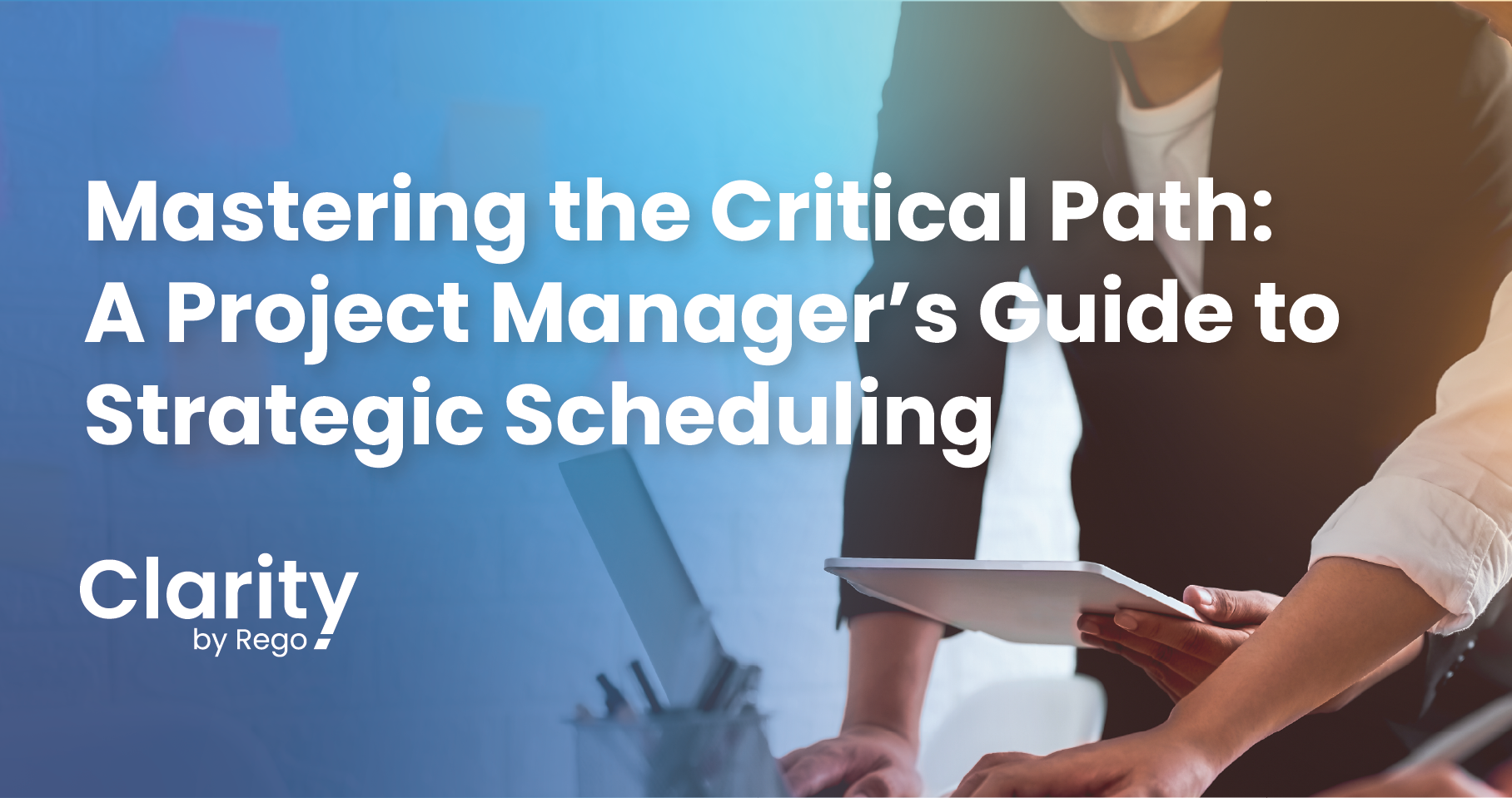by Clarity by Rego
Share
- Mastering the Critical Path: A Project Manager’s Guide to Strategic Scheduling
- What Is the Critical Path?
- Why Critical Path Matters
- How to Find Critical Path for Your Team
- Advanced Concepts: Total Float, Near-Critical Paths, and Path Drift
- Critical Path Isn’t Just for Waterfall
- What Good Project Managers Do with This Information
- Rego’s Take: Using Critical Path to Drive Portfolio Health
- Final Thought: Make It a Habit
- Get Notified of Updates.

If you’ve spent any time managing complex projects, chances are you’ve heard someone ask, “What’s on the critical path?” It’s one of those terms that gets thrown around often, but do we all truly understand its impact? More importantly, are we leveraging it to drive better decisions?
At Rego Consulting, we’ve helped hundreds of organizations—from Fortune 500s to nimble PMOs—refine their project delivery systems. One of the most underutilized (and misunderstood) concepts we see is the critical path. So, let’s demystify it and, more importantly, explore how to use it as a strategic tool and not just a scheduling mechanic.
What Is the Critical Path?
In the simplest terms, the critical path is the longest sequence of dependent tasks that determine the minimum project duration. If any task on this path is delayed, the entire project will be delayed.
It’s called critical because it represents work that has zero slack. There’s no room for delay on these tasks unless you want to push the end date. Everything else, like non-critical work, has some wiggle room, often referred to as float or slack.
Why Critical Path Matters
Knowing your critical path helps you:
But here’s what many teams get wrong: they treat the critical path as a static report. Something the scheduler pulls up once a week and reports in a Gantt chart. The critical path is a living, breathing diagnostic tool.
How to Find Critical Path for Your Team
Most project management tools, like Clarity PPM, can calculate the critical path. But these tools are only as good as the data you feed them.
Here’s what you need to get right:
At Rego, we recommend a critical path validation exercise every time a schedule is baselined. This includes running what-if scenarios, stress-testing durations, and doing a dependency audit. It’s a QA for your timeline.

Advanced Concepts: Total Float, Near-Critical Paths, and Path Drift
If resource management and capacity planning were easy, every organization would excel at them. Here are a few tips to help you begin your resource management and capacity planning journey.
1. Total Float vs. Free Float
Why this matters: not all non-critical tasks are equally non-critical. Tasks with low float are potential risks waiting to happen.
2. Near-Critical Paths
Projects rarely have just one sequence of work that’s important. A near-critical path has almost zero float-meaning it’s just one delay away from becoming critical.
Seasoned project managers track these just as carefully. If your critical path has five days of buffer, but your near-critical path has one, guess which one is more likely to slip?
3. Path Drift
Over the course of a project, the critical path can change. As durations shift, tasks complete early or late, and new dependencies emerge, the path can “drift.”
If you’re not tracking the drift, you might be optimizing against yesterday’s plan.
Critical Path Isn’t Just for Waterfall
Critical path doesn’t apply only to agile or hybrid teams. While you may not be building a fully networked Gantt chart in Jira, the concept of a chain of dependent deliverables that determine when value is shipped still holds. Even in sprints, dependencies between epics or integration points can create a hidden critical path.
Agile teams should routinely identify the highest-risk dependency chains that threaten release timelines and treat them like critical path tasks. The language might differ, but the strategic value is the same.
What Good Project Managers Do with This Information

Knowing the critical path isn’t enough. What matters is how you act on it. Great project managers:
Rego’s Take: Using Critical Path to Drive Portfolio Health
Critical path analysis is useful at the project level, but its also a portfolio management superpower.
In Clarity PPM, you can:
This helps PMOs and EPMOs make smarter sequencing decisions, protect strategic initiatives, and ensure that the org is working on what matters most, when it matters most.

Final Thought: Make It a Habit
At Rego Consulting, we don’t believe in process for process’s sake. But the critical path is different. It’s the core of your timeline. And with a little discipline, it can transform how you plan, manage, and lead.
So, the next time someone asks, “What’s on the critical path?” Use the question as an opportunity to refocus, reprioritize, and reassert control over your project’s ultimate outcome.
Because when you know what’s critical, you can act like it. Need more guidance? Reach out to us at https://clarityppm.com/
STAY IN THE LOOP
Get Notified of Updates.
Stay ahead of the curve by subscribing to our newsletter. Get the latest insights, strategies, and tools delivered straight to your inbox, and empower your business to achieve more.

